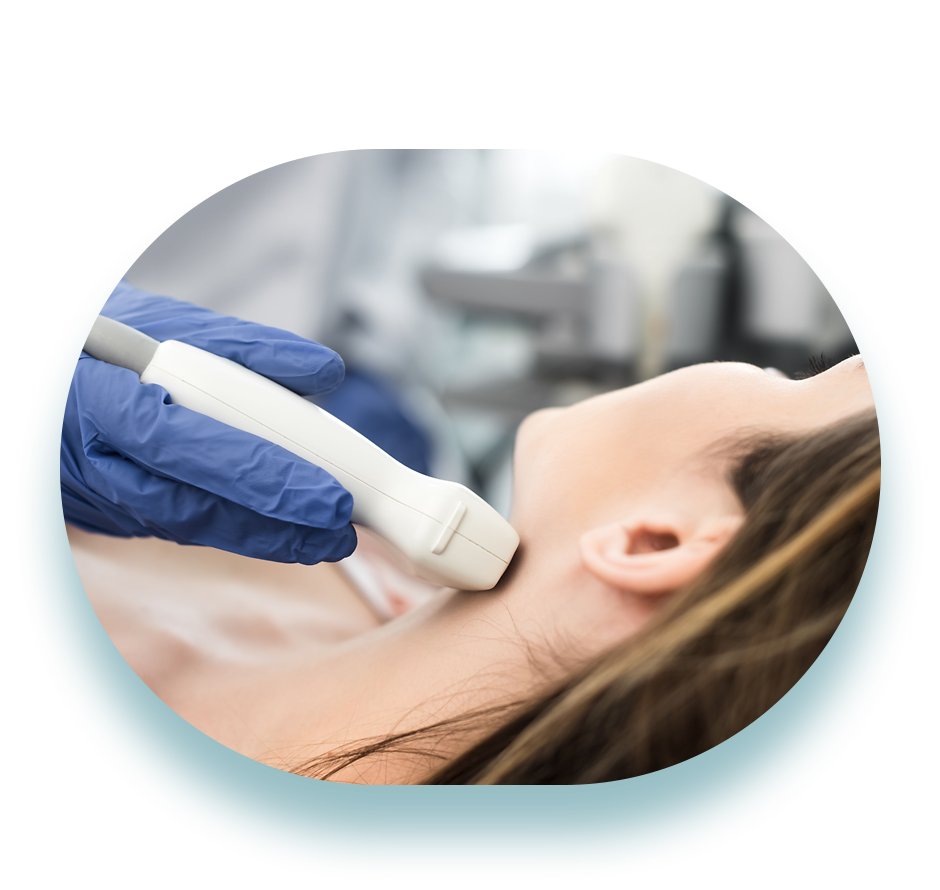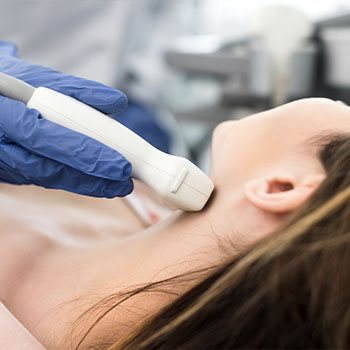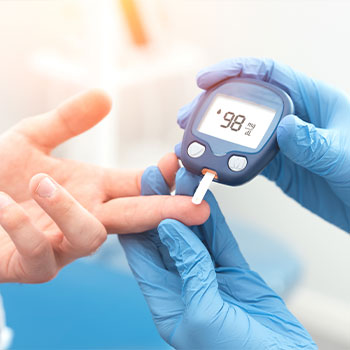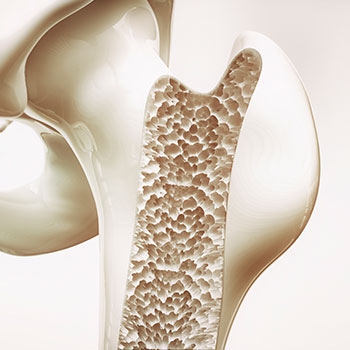MUNICH
PRIVATE PRACTICE
Nordendstraße 64
80801 Munich
T. 089 / 189 46 85 0
F. 089 / 189 46 85 20
MUNICH – PRIVATE PRACTICE
Nordendstraße 64
80801 Munich

Hormone specialists for hormonal imbalances
Our endocrinologists measure all known hormone levels and offer functional tests, as well as sonogrammes in order to adequately and professionally diagnose and treat complex hormone disorders.
The symptoms listed below can be an expression of a hormonal imbalance. We would gladly help you with any clarification:
Overweight, obesity, unexplainable weight gain or loss
Tiredness, exhaustion
Sleep disorders, psychological changes
Menstrual cycle disorders and difficulties to concieve
Sexual desire disorders and impotence
Excessive sweating
Hair loss, increased body hair
Acne
DISEASES OF THE THYROID
Underactive Thyriod
Hypothyroidism is reduced production or non-production of thyroid hormones.
An underactive function is diagnosed by an excessively high level of the control hormone TSH (thyroid stimulating hormone) with a simultaneous reduction in one or both levels of the thyroid hormones, free T3 (triiodothyronine) and free T4 (levothyroxine). An incipient underactive function (also called subclinical hypothyroidism) is present when only the TSH value is increased, but the values for free T3 and free T4 are still in normal range.
The typical physical signs of an underactive thyroid are:
The feeling of freezing, sensitivity to cold
Weight gain
Slower pulse rate
Fatigue
Cold, dry skin, hair loss
Water retention (edema)
Muscle weakness
Tiredness
Difficulty or the lack of concentration
Depression
Constipation
Common causes of an underactive thyroid are:
Autoimmune thyroiditis (Hashimoto's thyroiditis)
Treatment with a too low dose of thyroid hormones
An excessive dose of thyroid hormones to treat an overactive thyroid
The following are very rare causes of an underactive thyroid:
Congenital underactive thyroid (one child in 3500 births)
Subacute thyroiditis (De Quervain)
A malfunction of the pituitary gland
The most common cause of an underactive function is Hashimoto's thyroiditis (Autoimmune thyroiditis). A dysregulation of the immune system leads to the formation of antibodies that can be measured in the blood and impair the function of the thyroid gland, which can lead to a long term extensive loss of organ function or the complete destruction of the gland.
An underactive function with a painful subacute thyroiditis (proper name: De Quervain) is usually only a temporary inflammation of the thyroid gland. A normal function usually returns once the inflammation has subsided.
Hypothyroidism often appears after surgical removal or partial removal of the thyroid and often after radioiodine therapy. Regular blood checks are necessary (an annual check is usually sufficient after the initial appointment).
There are a number of causes for congenital hypofunction. The thyroid can be completely absent, only half formed, or even in the wrong place. In addition to these organ malformations, there are congenital errors in hormone production or defects in the secretion of thyroid hormones from the thyroid cells. A blood test for hypothyroidism in newborns up until the fifth day of life, is required by law as a rule, for early detection of an underactive function.
Overactive Thyroid
Hyperthyroidism is the increased production of thyroid hormones. An overactive function is diagnosed by a low level of the control hormone TSH (thyroid stimulating hormone) with a simultaneous increase in one or both levels of the thyroid hormones free T3 (triiodothyronine) and free T4 (levothyroxine). An incipient overactive function (also called latent/subclinical hyperthyroidism) is present when only the TSH value is low, but the values for free T3 and free T4 are still in the normal range.
The physical signs of an overactive thyroid are:
Increased sweating
Weight loss
Faster pulse rate
High blood pressure
Trembling hands
Muscle weakness
Inner restlessness, insomnia, difficulty concentrating
More frequent bowel movements, sometimes diarrhea
Common causes of an overactive thyroid are:
Thyroid Autonomy ("hot nodules")
Graves’ disease (Basedow's disease)
Treatment with a too high dose of thyroid hormones
The following are very rare causes of an overactive thyroid:
Congenital overactive thyroid
The beginning phase of thyroid inflammation through "cell breakdown"
In Germany, the most common cause of an overactive thyroid is an autonomic dysfunction (autonomy), followed by Graves’ disease (Basedow's disease).
Autonomy means an overproduction of thyroid hormones, no longer subject to the normal regulation by the pituitary gland as the control organ of hormone production. There are often individual nodules in the thyroid gland that cause this overproduction. These are also known as hot nodules and are mostly benign. Sometimes though, the entire thyroid produces too many hormones.
The technical term for this is "disseminated autonomy".
Graves' disease (Basedow’s disease) is one that affects the entire thyroid gland and is an autoimmune disease. Autoimmune diseases are disorders in the body's immune system where, in this case, certain thyroid structures are seen as foreign bodies and a defense reaction is activated. The body forms proteins (antibodies) that activate hormone production.
Treatment with a too high dose of thyroid hormones, used to treat hypothyroidism and suppress the growth of thyroid nodules, or used to treat thyroid cancer, can also cause symptoms of hyperthyroidism. Congenital hyperthyroidism is very rare and is usually caused by changes in genetic material.
Occasionally, autoimmune inflammation of the thyroid gland (Hashimoto's thyroiditis) or subacute thyroid inflammation (De Quervain) can lead to a hyperfunction lasting only for a few weeks. This is caused by the release of thyroid hormones that have been pre-produced and stored in the thyroid gland. Usually this disorder resolves spontaneously, but may lead to temporary or persistent hypothyroidism.
Graves‘ disease (Basedow’s disease)
Basedow's disease is named after the German doctor Carl von Basedow, who described the details of the disease in 1840. It causes an overactive thyroid gland and in some cases, also affects other organs (eyes, connective tissues of the lower legs, hands and feet). This overactive function of the thyroid gland is caused by the production of proteins in the body (antibodies), which leads to an uncontrolled production and formation of thyroid hormones. The typical antibodies of this disease are the TSH receptor antibodies (TRAK), which can also disappear again during the course of treatment. Two other antibodies are also often measurable, thyroid peroxidase (TPO-AK) and thyroglobulin (Tg-AK). An overactive thyroid develops quickly and shows the typical signs of increased hormone production.
Graves' disease tends to run in families without a typical hereditary disposition and often includes family members who have Hashimto's thyroiditis. It is assumed that certain genetic changes are responsible for the disease, but unfortunately the onset cannot be predicted. It can be linked to previous viral infections or severe mental stress. However, the disease can also appear out of complete well-being.
As with Hashimoto's thyroiditis, possible accompanying diseases are vitiligo, vitamin B12 deficiency (the cause being autoimmune damage to a certain type of cells in the stomach), gluten intolerance (celiac disease) insufficiency of the adrenal glands (Addison's disease) or type 1 diabetes mellitus. A polyglandular ("multiple gland disease") autoimmune syndrome presents itself when several of these autoimmune diseases occur.
The treatment is usually with medication that blocks the thyroid hormone production (thiamazole, carbimazole, propylthiouracil), initially for about a year. There is then about a 50% chance that the disease will be cured and therefor the medication no longer needed. Even when the hyperthyroidism is eliminated, stopping the medication too soon can lead to a recurrence of the dysfunction, since the medication not only suppresses the overactive function but also has a beneficial effect on the autoimmune system. If there is no improvement after one or one and a half years of treatment, a decision should then be made for a treatment that results in complete thyroid suppression. Undesirable side effects can occur if the treatment is continued over many years or even life-long. The thyroid function can be “switched off” permanently by radioiodine therapy or surgery. The method of choice is radioiodine therapy, unless there are additional suspicious nodules in the thyroid gland or the gland is very large (larger than 50 ml volume, measured with an ultrasound) which now also can be used safely in young patients. After radioiodine therapy or surgery (removal of the entire thyroid gland), it is necessary for the patient to permanently take thyroid hormone replacement therapy. However, there are significantly fewer complications and side effects than with the long-term use of medication used to suppress the hormones.
Eye symptoms in Graves' disease (endocrine orbitopathy)
Unfortunately, in some cases, swelling of the region around the eyes, inflamed eyes and a dry-eye syndrome with photophobia, increased tears and pressure, can occur. Causes are blinking too infrequently, an increase in connective tissue and sometimes swelling of the eye muscles. In severe cases, the result can be visual impairment and double vision. Dry-eye syndrome can usually be treated with moisturizing eye drops, ointments or gels. If the eyeballs protrude or there is severe swelling, treatment with cortisone may be necessary. In mild to moderate cases, supplementary treatment with selenium can be helpful. A prerequisite for treatment of the eyes is a good control and review of the thyroid metabolism. After radioiodine therapy, it is essential to treat with cortisone, otherwise the eye symptoms can worsen. In patients with eye symptoms, radioiodine therapy should always be applied with the appropriate protection. Surgery of the thyroid in these patients is often preferred, but even operated patients may experience an increase in ocular symptoms. A decision on the appropriate "definitive" therapy can therefore only be made on a case-by-case basis. Swelling in the lower legs (pretibial myxedema) and in the hands and feet (bone changes, "acropachy") are less common but in severe cases, treated with cortisone.
Hashimoto's Autoimmune thyroiditis
Autoimmune thyroiditis (Hashimoto's thyroiditis) is the most common thyroid disorder in adulthood that leads to hypothyroidism, the cause being a disorder of the immune system. Proteins (antibodies) build up in the blood, which leads to an inflammatory reaction in the thyroid gland and disruption of thyroid hormone production. In some patients, the thyroid gland becomes enlarged, while in others, it becomes smaller over time. It is virtually impossible to discern in which patients with this disease, a shrinking of the thyroid occurs or in whom the thyroid function fails permanently. The typical antibodies found in the blood for Hashimoto's thyroiditis are thyroid peroxidase (TPO-AK) and thyroglobulin (Tg-AK). Thyroid function and antibody levels are not always linked, so that high antibody levels do not necessarily mean severe hypofunction and vice versa.
The antibody levels vary often during the course of the disease and higher levels do not automatically mean a worsening of the disease. Many patients with normal thyroid hormone levels but with an increase in antibody levels, do not require treatment. In these patients, however, the TSH-level should be measured once or twice a year so that an incipient hypofunction is not overlooked. If the disease is not diagnosed at an early stage, the typical symptoms of hypothyroidism can occur. The treatment aims at replacing the thyroid hormone deficiency. If thyroid hormone production fails, lifelong thyroid hormone replacement therapy is usually necessary.
Hashimoto's thyroiditis can be hereditary and can be linked to one or more autoimmune diseases. Some patients also suffer from vitiligo, vitamin B12 deficiency (caused by autoimmune damage to a certain type of cell in the stomach), gluten intolerance (celiac disease), adrenal gland insufficiency (Addison's disease) or from type 1 diabetes mellitus. If several of these autoimmune diseases occur, then it is called polyglandular ("multiple glands") autoimmune syndrome.
Postpartum thyroiditis (autoimmune thyroiditis after childbirth )
In Germany, it is estimated that the development of an autoimmune disease of the thyroid gland, will appear in about 7% of all cases after giving birth. This postpartum thyroid disease, more often affects women in whom thyroid antibodies were previously detected. Occasionally, at the beginning of the disorder, the thyroid gland becomes overactive for a short time, as a result of the release of pre-formed thyroid hormones caused by inflammation of thyroid cells. The lack of post-production can then lead to temporary or permanent hypothyroidism. The disease is often only diagnosed much later, since the symptoms (tiredness, exhaustion, depressive mood) in first-time mothers, are associated with the general situation of the young mother and not with the thyroid gland.
Thyroid nodules
Thyroid nodules are commonly found in many patients in Germany. Studies have shown that about 25% of all adults have thyroid nodules or cysts. The main reason is iodine deficiency, which was still clearly present in Germany until the early 2000s. In recent years, the supply of iodine has improved, through the use of table salt containing iodine, in private households and in the catering and food industry. Thyroid nodules can be palpated by the doctor, but are easier seen on an ultrasound. In addition, a scintigraphy is used, which can differentiate between so-called "hot nodules" and "cold nodules" (if the nodule is larger than 1 cm).
In Germany, the majority of thyroid nodules are benign, only in very rare cases is thyroid cancer diagnosed. Thyroid nodules almost never cause symptoms. Only when they get very large can they lead to a feeling of pressure in the throat or difficulty in swallowing. The laboratory hormone levels for thyroid nodules are usually normal. Normal levels checked at a family doctor say nothing about the presence of thyroid nodules. In a few cases, hot nodules (unifocal autonomy) may be diagnosed.
Hot nodules (uni-, multifocal autonomy)
"Hot nodules" are generally benign, but can cause an overactive thyroid gland. One hot nodule is called "unifocal autonomy", if there are several hot nodes, it is then called "multifocal autonomy". The overactive function usually develops slowly, recognizable by a drop in the TSH level in the blood. A sudden high intake of iodine (e.g. through X-ray contrast media with a high iodine content) can lead to an acutely triggered hyperthyroidism in pre-existing "hot nodes". However, the occasional consumption of sea fish, the daily use of iodised table salt and trips to the sea do not affect thyroid function to any relevant extent. Autonomous sections of the thyroid are detected in a scintigraphy. If the thyroid metabolism is normal, treatment is not mandatory, but the TSH levels should be checked once or twice a year so that an incipient overactive function is not overlooked. The patient should be made aware of the risk of an overactive function being triggered by iodinated X-ray contrast media.
However, if an "antidote" in the form of perchlorate (trade name Irenat) is administered beforehand, X-ray contrast media can be used for necessary examinations. In the case of a beginning overactive function, definitive treatment is sought. Radioiodine therapy is very well suited in eliminating autonomy. Surgery is only preferred if there are additional suspicious nodular changes in the thyroid gland. An overactive function can be treated with medication until the radioiodine therapy is applied.
Cold nodules
"Cold nodules" with reduced thyroid metabolism, are usually seen in a scintigraph if they are larger than one centimeter. The vast majority of cold nodules are benign.. Only about 2% of cold nodules are malignant. A thyroid gland operation is therefore only necessary in the minority of cases: if there is a suspicion of malignancy, if there are signs of displacement of an enlarged thyroid gland (e.g. narrowing of the trachea) or if the patient has clear symptoms (difficulty swallowing, a strong feeling of pressure in the throat). A fine-needle biopsy should be done for clarification, if a cold nodule shows signs of malignancy, after an ultrasound examination.
Medicated treatment of thyroid nodules
Medicated treatment of thyroid nodules is possible once malignancy has been ruled out (see "cold nodules"). In Germany, it makes sense to combine treatment with iodine, since a quarter of people with thyroid nodules still have an iodine deficiency.
A combined treatment with iodine and thyroid hormones is more effective and is usually prescribed for a year initially, after which the effect of the therapy must be checked. Further treatment with pure iodine is possible.
Diseases of the adrenal glands
Adrenal Gland
The adrenal glands are small organs located above both kidneys. They are one of the main hormone producing glands in the body and produce, amongst other stress hormones, the vital hormone "cortisol". The size of each adrenal gland is about 4x3x2 cm and consists of two parts: the adrenal medulla on the inside and the adrenal cortex on the outside. The stress hormones adrenaline and noradrenaline are produced in the adrenal medulla, and the hormones aldosterone, cortisol and DHEA, in the adrenal cortex. Both the deficiency and the overproduction of the various adrenal hormones lead to clinical relevant symptoms.
The information on our website is provided for patients, but in no case can it replace a consultation with a doctor. Only the doctor can assess all the details of the individual case, provide further information and initiate the necessary diagnostic and therapeutic measures. The information given here corresponds to the state of knowledge in 2012. New findings can outdate parts of it or the entire presentation.
Source with kind permission: www.endokrinologie.net/illnesses-nebenniere.php
Cushing’s syndrome
The symptoms of Cushing's syndrome develop as a result of abnormally increased production of the adrenal hormone cortisol. The vast majority of Cushing's disease are caused by a benign tumor of the pituitary gland that causes the overproduction of the hormone ACTH. In this case, one speaks of the so-called Cushing's disease. ACTH then stimulates adrenal hormone production, leading to an increase of cortisol in the blood. However, the source of the ACTH overproduction can also lie in other organs (so-called ectopic Cushing's syndrome). In addition, tumors of the adrenal gland (benign adenomas or malignant carcinomas) can directly produce cortisol.
Symptoms of this disease are: weight gain, especially around the abdomin, a round „full moon“ face with hamster cheeks, arms and legs remain slim and stretch marks can appear on the abdomen, hips and armpits, they are wider than normal stretch marks and often appear red due to minor bleeding (red stripes - striae rubrae).
However, only a very small proportion of people who gain weight have Cushing's syndrome. Due to increased vascular fragility, Cushing's syndrome also leads to frequent bruising and poorer wound healing. Additional signs can include increased male type body hair (hirsutism) in an affected woman and acne in both sexes. The skin can also become thinner overall ("parchment skin"). Typically, the menstrual cycle of affected women becomes irregular or does not occur at all (amenorrhea). There is often a loss of muscle strength (myopathy), which specifically affects the buttocks and thigh muscles. This typically results in difficulty climbing stairs or getting up from squatting. Furthermore, too much cortisol can have a negative effect on the mind, which triggers more anxiety and depression as well as causing mood swings.
Too much cortisol also has serious metabolic and circulatory effects. This can lead to diabetes (diabetes mellitus), which corresponds to the so-called adult-onset diabetes. The effect of cortisol on the blood pressure regulating system of the kidneys can lead to high blood pressure and simultaneously deplete the body of potassium. Low blood potassium is potentially dangerous when trying to maintain a normal circulatory function, especially a regular heart rhythm. Excess cortisol also has an unfavorable effect on the bones and leads to the loss of bone mass (osteoporosis). Depending on how severe the Cushing's disease is, it can lead to fractures of the vertebrae, usually manifested by sudden back pain.
Source with kind permission: www.endokrinologie.net/cushing-syndrom.php
DISEASES OF THE PITUITARY GLAND
Pituitary insufficiency
The symptoms of a deficiency or complete lack of production of one or more of the hormones of the pituitary gland (pituitary insufficiency), lead to a minimal function or even non-function of the respective end organs. Growth hormones are primarily responsible for growth in childhood and adolescence, and later in life they play a role in regulating metabolism.The first disturbance of pituitary function often appears in the growth hormone axis (short stature in children or metabolic disorders in adults, changes in body composition and deterioration in the quality of life) and the sexual hormone axis.
Luteinizing hormone (LH) and follicle stimulating hormone (FSH) are responsible in women for the release of estrogen and the maturation of the egg cells in the ovaries and in men for testosterone production and the maturation of sperm in the testicles. A lack of LH and FSH manifests itself in childhood through disturbances in puberty development and through menstrual disturbances in women, or a loss of libido and potency in men. A persistent lack of estrogen or testosterone can lead to osteoporosis, loss of body hair, loss of muscle mass and energetic drive.
Prolactin is important for milk production during breastfeeding. Otherwise, its lack of production has no relevantly known adverse effect.
The adrenocorticotropic hormone (ACTH) stimulates the adrenal glands to produce cortisol and other hormones, especially in stressful situations. Disorders of the adrenal hormone axis are less common and usually occur later in life, the symptoms being weakness, tiredness, weight loss, pallor, nausea and hypoglycaemia.
The thyroid-stimulating hormone (TSH) stimulates the thyroid gland to produce and release thyroid hormones. Symptoms of damage to the thyroid hormone axis include weight gain, fatigue, constipation, circulatory problems and a variety of mental health issues. In the case of tumors situated above the pituitary gland or after surgical interventions, diabetes insipidus can develope through insufficiency of the posterior pituitary gland with a deficiency or lack of production of the antidiuretic hormone (ADH). Characteristic symptoms are an increased production of urine and a corresponding increase in thirst. In addition to the lack of hormon production, symptoms such as headaches and visual disturbances and field defects can occur, in the case of large tumours, due to pressure on neighboring structures, e.g. the optic nerves. The most severe form of partial or complete anterior pituitary insufficiency is the pituitary coma with metabolic derailment and unconsciousness as a result of the insufficiency of the thyroid hormone and adrenal hormone axis.
The release of individual pituitary hormones is controlled by a superordinate center in the brain, the hypothalamus. Pituitary insufficiency can be caused by congenital or acquired defects in the pituitary or hypothalamic area. One of the most common causes is a benign tumor of the pituitary gland (pituitary adenoma). Other causes include inflammation, bleeding, craniocerebral trauma or radiation.
Source with kind permission: www.endokrinologie.net/hypophyseninsuffizienz.php
Acromegaly
Acromegaly is caused by a benign tumor of the pituitary gland which releases an increased and uncontrolled amount of growth hormone. An increased secretion or production of growth hormone (somatotropic hormone [STH] or [GH]) leads to acromegaly. If this occurs in childhood, gigantism develops. The frequency (incidence) is 3-4 patients/mill/years. This means that there are between 250-330 new cases per year in Germany. At present, there are around 3000-6000 patients with acromegaly. It usually takes about eight years from onset of the first symptoms, for a diagnosis. Symptoms develops slowly, without a sudden change in appearance.
The diagnosis is often coincidental e.g. when changing doctors and then the acromegaly is usually already far along. The chance of a cure at this point is significantly low, compared to when diagnosed in the early stages of the disease. In very rare cases, acromegaly can be caused by other defaults and not by a tumor of the pituitary gland (less than 1% of patients).
Clinical signs and symptoms:
Acromegaly is mostly diagnosed between the 3 and 5 decades. The patients complain of being easily tired, reduced physical resilience, lack of concentration, increased tendency to sweat, often headaches and occasionally various joint problems. The skin becomes thick and shows a clear tendency to sweat with increased sebum secretion (seborrhea) and is often not perceived as pathological.
The hands are clumsy and characteristically warm and moist, and increased in consistency and width. Changes in the connective tissue and the bones lead to typical acromegalic facial features: pronounced forehead, deep wrinkles around the mouth and a protrusion of the eyelid ridges.
Other symptoms can be carpal tunnel syndrome (paraesthesia in the first three fingers of the hand due to pressure on the median nerves in the wrist), as well as snoring and sleep apnea syndrome (brief pauses in breathing during sleep). Further typical signs of acromegaly are a separation of the teeth in the lower jaw, enlargement of the tongue and a deep voice. Complications often found are diabetes, high blood pressure and joint changes. The growth in the pituitary gland can lead to restrictions in the function of the healthy part of the gland (menstrual disorders, insufficiency of the adrenal glands or thyroid gland). If the tumor expands upwards, the optic nerves are impaired with tunnel vision and even loss of vision.
Source with kind permission: www.endokrinologie.net/akromegalie.php
Endocrine hypertension
High blood pressure (arterial hypertension) is a chronic disease that affects around 25% of the total population of western industrialized nations. There is a clear connection between high blood pressure and the rate of cardiovascular complications such as a heart attack or stroke. Nevertheless, about two thirds of patients with arterial hypertension are not treated or not adequately treated. When the blood pressure is not brought below 140/90 mmHg despite treatment with at least three blood pressure reducing drugs including a diuretic, this is then referred to as therapy-resistant hypertension.
There are many causes of hypertension that range from insufficient medication or irregular intake of medication to undetected secondary hypertension. In addition to kidney diseases, secondary hypertension could be caused by hormonal disorders. The most important causes of endocrine hypertension are primary hyperaldosteronism, hypercortisolism and pheochromocytoma.
The complaints of patients with secondary hypertension can be caused, on the one hand by cardiovascular complications and on the other hand by hormonal overproduction (see Cushing's syndrome, pheochromocytoma and primary hyperaldosteronism).
A pheochromocytoma as cause of hypertension is very seldom, between 0.2- 0.4 % and hypertension through Cushing's syndrome is only found in about 0.3%. Conn's syndrome with hypokalemia is found in 0.1-1.0% of all hypertensive patients, compared to that of normokalaemic Conn's syndrome, which is around 8-12%, making it the most common form of secondary hypertension. This means around 12% of all forms of hypertension are caused by diseases of the adrenal glands.
As cushing's syndrome and pheochromocytoma are so rare, there is no justifiable screening for this disease in hypertensive patients and there are no further diagnostics to rule out primary hyperaldosteronism in a patient with easily treatable hypertension. An early diagnosis of hormone-related high blood pressure is of great importance for the affected patients in order to prevent secondary diseases. Particular attention should be given to patients in whom a growth was detected during further diagnostics in the adrenal gland. These tumors, also known as incidentalomas, can be the starting point for autonomous hormone secretion and therefor contribute to high blood pressure.
Therapy depends on the underlying cause: With the exception of bilateral adrenal hyperplasia in primary hyperaldosteronism, surgical therapy is generally the therapy of choice in the three syndromes mentioned.
Source with kind permission: www.endokrinologie.net/illnesses-endokrine-hypertonie.php
Prolactinoma
Prolactin-producing pituitary tumor.
A prolactin-producing pituitary tumor (pituitary adenoma) is the most common pituitary tumor next to the non-hormone-producing pituitary adenoma. It is called a prolactinoma and a distinction is made depending on the size, between a microprolactinoma (Ø < 10 mm) and a macroprolactinoma (Ø > 10 mm). The microprolactinomas, mainly found in women, are always benign. Macroprolactinomas, which are equally common in both sexes, are usually benign. Malignant, prolactin-producing pituitary tumors ("pituitary cancer") are very rare.
Prolactin is an important reproductive hormone in women. It alone enables the mother to feed her newborn with breast milk. In addition, prolactin ensures that the ovarian function is halted during the breastfeeding phase so that the woman cannot fall pregnant again during this time, only if the mother breastfeeds her child at least 7 or more times a day ("Natural Birth Control"). Men also produce prolactin in their pituitary gland, but this has no recognizable physiological significance.
Source with kind permission: www.endokrinologie.net/prolaktinom.php
Hormone-inactive pituitary adenoma
Early signs:
In contrast to hormone-active tumors, hormone-inactive pituitary tumors (HIA) do not have many specific symptoms. They usually only arise as a result of the pressure of the slowly growing benign tumor on the pituitary gland. The overlying optic nerve usually creates disturbances in the visual field or, more rarely, double vision. The visual disturbances are initially quite uncharacteristic, such as blurred vision, normally not treatable at an optician. Even if the visual field test or visual acuity test is normal, yet changing visual problems occur, the patient should discuss further examination through a MRI with their doctor.
Headaches, mostly in the forehead and eye area may be present. Menstrual disorders and a decrease in libido can be early signs, especially if an increase in prolactin occurs due to pressure on the pituitary stalk. This disrupts the release of the sexual hormones in both men and women.
Late signs and course without treatment:
General exhaustion, loss of libido, freezing, circulatory disorders and low blood pressure can all be signs of an increasing hormone deficiency and can lead to a coma or circulatory failure under stress. In most cases, an insufficiency of growth hormone (hGH) and insulin-like growth factor I, (IGF-I) initially occur. This leads to muscle weakness and dyslipidemia, followed by the deficiency of sexual hormones, and finally thyroid hormones and cortisol, with the life-threatening consequences mentioned previously. The expansion in the direction of the optic nerve can cause blindness in one or both eyes and the strong pressure on the middle brain base can cause further brain disorders.
Source with kind permission: www.endokrinologie.net/hypophysenadenom.php
PCO Syndrome
Das Polyzystische Ovarsyndrom
Polycystic Ovary Syndrome (PCOS) is a disease that occurs in about 5-10% of reproductive women. The onset of this disease is usually between the ages of 15 and 25 years.
PCOS is characterized by menstrual cycle disorders (A or oligomenorrhoea) in combination with increased production of male body hair (hirsutism), acne, hair loss (alopecia) and/or an increase in male sexual hormones in the blood (hyperandrogenemia). Firstly, any other disorders or diseases of the pituitary gland, adrenal gland and the ovaries must be ruled out. According to the NIH (National Institutes of Health) in 1990, the classic polycystic ovaries, with the name originally given by Stein and Leventhal 1935, is sonographically found in only 70% of patients.
PCOS has the tendency to be hereditary, so the cause is presumably a genetic component. So far, however, there are many heterogeneous results from various studies. A connection between the PCOS and the metabolic syndrome has also been established in numerous studies. The metabolic syndrome includes overweight (obesity), sugar utilization disorders (diabetes mellitus), blood fat levels (hyperlipidemia), high blood pressure (arterial hypertension) and vascular calcification.
However, PCOS is not only characterized by the physical symptoms but also the psychosocial symptoms, especially through the increased masculine body hair, obesity and infertility, having a clear impact on this level with massive limitations in the quality of life, satisfaction and sexuality.
Extensive examinations are necessary in order to diagnose PCOS. This always includes a detailed discussion with the patient (starting with the first period, menstrual cycle, development of puberty, family history, etc.). A physical examination with assessment of the skin and body hair and blood tests with determination of various hormones. In addition, an ultrasound examination of the ovaries should be included.
A disease of the pituitary gland, the adrenal gland and the ovaries must be ruled out. In addition, an examination of the thyroid function is necessary, since some PCOS patients also suffer from autoimmune inflammation of the thyroid gland (autoimmune thyroiditis), which can lead to hypofunction. Just like PCOS, this hypothyroidism can be the cause of an unfulfilled wish to have children.



![[Translate to English:] Abnehmen - Adipositas-Therapie in München [Translate to English:] Abnehmen - Adipositas-Therapie in München](/fileadmin/user_upload/ZESM/teaser/zesm_t_350x350_adipositas.jpg)

